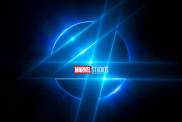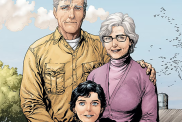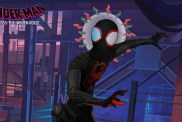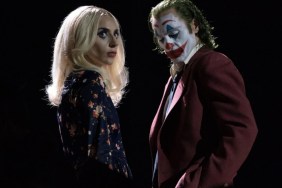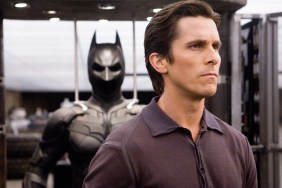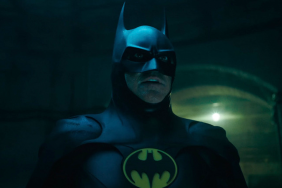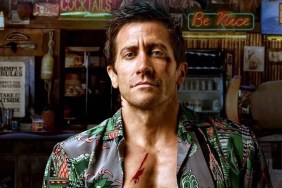
Batman super fans know Michael Uslan’s name, but if you don’t, you should. He’s the reason we got our first Batman film. After obtaining the rights in the late 1970s when no one else wanted them, Uslan fought hard to get the Tim Burton film made. Since then, he’s been either a producer or an executive producer on every on-screen Batman project out there. If you’re a Batman fan and you haven’t read his memoir “The Boy Who Loved Batman,” go out and get it right now! Check out what he had to say about Batman’s history, the people behind it, the new film and which superhero he’d love to take on.
SuperHeroHype: When we spoke recently, you told me about the movement to get more recognition for Jerry Robinson and Bill Finger… How do you feel about that? What sort of things are being done?
Michael Uslan: Well, first of all, I’m very, very supportive of Athena Finger and the family. And this was something that Jerry Robinson experienced and I was very happy to see how much he was included in The Dark Knight and The Dark Knight Rises. He was flown over to England and had a chance to be on the set, but you know all these things are great when they happen. And in terms of Bill, I am probably one of the few people left standing who met Bill Finger. I met him on two occasions when I was a kid. Once at the very first comic book convention ever held, which, I can tell you, next week will be fifty years. So, I met Bill fifty years ago next week. I was introduced to him – did I ever tell you this story?
SHH: No.

Now, Otto Binder was my first mentor into the world of comics and the history of comics. He was one of the first people I ever interviewed for one of these things called a fanzine, just when comic book fandom was really beginning to organize. And Otto lived in New Jersey, and allowed me and Bobby to come up and spend ten hours with him one day, and it was magical. In fact, I’ve devoted a couple of chapters in my book to Otto and his family. So Otto saw us, and he goes, “Michael! Bobby! Come on in, fellas!” And Bobby and I, each thirteen, walk into this bar and sat down to the right of them. And he said “What are you guys drinking?” And of course, in that bar, with the bartender that looked like Long John Silver from the pirate movie I’d seen (though he didn’t have a parrot on his shoulder), we could have ordered anything, I’m sure. And then Otto turns to us and says, “Boys, how would you like to meet the creator of Batman?” And our jaws dropped and we said, “Yeah!” He said, “Fellas, meet Bill Finger.”
SHH: Wow.
Uslan: The other time I met Bill was also around when I was thirteen. Whenever we had a day off from school – I forget if it was a Tuesday or a Thursday – DC Comics had a weekly tour in the afternoons. So whenever possible, we’d convince my mom to take us to New York and we would go on the DC tour. On my very first DC tour, they let us walk around the production bullpen area at 575 Lexington Avenue. And they’d given out these pictures – like color portraits of Superman and other tchotchkes we could take home – and I went around from table to table, asking each person there to sign. Now, understand this was in an era where there was no internet, there were no Comic-Cons, so we had no idea who people were, or, particularly, what they looked like. And I went around and this one guy I recognized as my favorite artist at the time – Murphy Anderson, because he actually had some of his work signed – he signed it, then I went over to another guy who was sitting there, and he was writing, and he signed it, and it was Bill Finger. So I actually have Bill’s autograph and I reproduced that in my book, “The Boy Who Loved Batman.” So that’s how far back I go, just in retrospect.

And so Bob Kane went back and redrew and he said, “You know, I’m a big fan of the fandom in the comic strips. One of the reasons he looks so mysterious is that they’ve whited out his eyes without whiting out his eyes.” He worked out if you gave him – ultimately he said bat things coming out of his gloves, and they talk about the utility belt. And finally Bob had a drawing and he said, “This looks great. So who is he and what’s his story?” And Bob had not yet thought that out. So Bill Finger said, “All right, we’ll call him Bruce Wayne, and that goes back to Mad Anthony Wayne and Robert Bruce. We’ll put him in a city,” and Bill eventually called it Gotham City and eventually gave him a car, which eventually became the Batmobile. And he asked again what his story was. So Bill eventually wrote a story in which young Bruce Wayne is walking at night with his parents and the parents are murdered and the young boy vows over his parents’ bodies that he will get the guy who did this, and as they say in the comics, thus was born this weird creature of the night, this avenger of the night; the Batman. So I now turn to you and I ask you, who are the creators of Batman?
SHH: Wow. Yeah, I’d say that’s a pretty good case.
Uslan: I make no case; I only ask questions.
SHH: You ask good questions. But that’s awesome! You know, I’m curious about what Jerry Robinson thought of The Dark Knight, considering what he had to do with the Joker.
Uslan: Jerry loved it. He absolutely loved it. I miss him dearly. Our last time doing our dog and pony show together, Jerry and I spoke at the United Nations. And I have pictures from that; it was so memorable, and I told you about that night at the premiere of The Dark Knight with Jerry. And to have him; he meant so much to me – have him turn to me with tears in his eyes and say “This is the greatest night of my life” – that was incredible. An incredible moment. And to have his name on it as a creative consultant… It was just a great thing to see, especially since he was there, unlike Bill Finger who died penniless in 1974.
Head over to page 2 to hear Uslan talk about the rise of superhero movies with 1989’s Batman!
(Photo Credit: WENN.com)

SHH: You know, it’s funny. Hollywood has changed so much since all of this started, obviously since the Keaton Batman. What’s your take on it?
Uslan: The Batman movie in 1989, it’s important to discuss in the context of the time. And there are so many people today who are not – they don’t keep track of history. And you know I’m a history major, a history buff. And if there’s one thing that history tells us, it’s that if you don’t learn from it and understand it, you’re doomed to repeat it. At the time the Batman movie came out, it was revolutionary. A big tip of the hat to the important and wonderful work of Richard Donner on Superman in 1977. He blazed a path by having Marlon Brando play Jor El. That brought credibility from the mainstream to a Superman movie, to a reimagining of what Krypton looked like, curiousness of the Smallville sequence, yet as soon as Superman got to Metropolis and put on the cape, it got funny. It got very light in tone. By 1989 with Batman, things were changing rapidly. In 1986, the graphic novel was really bursting onto the scene between “Watchmen” and “The Dark Knight Returns.”
The importance of those books is that it opened the eyes of the general public for the first time to the concept that comic books were no longer simply being made for eight- to twelve-year-old boys. So that was an important cog in the wheel to all this. And then, to do Batman in a dark and serious way – nobody had done it before and that’s the main reason it took us ten years to get the first movie made. It was too bold, too daring; people thought I was crazy. We were rejected everywhere and it was an unbelievable stressed time. You have to understand that the generation that was running Hollywood at that time were people who had been adults in the 1950s when Fredrick Wertham published his book “Seduction of the Innocent,” attacking comic books as the cause of the post-WWII rise of juvenile delinquency. And these people all looked down on comic books, all looked down on the creators. At best, they thought of comic books were cheap entertainment for children. At worst, they thought they were a lurid tool of the devil that was turning an entire generation into delinquents. There were comic book burnings back then, in the mid-1950s. If it wasn’t for the advent of rock and roll, and Elvis Presley moved the spotlight onto that, the tool of the devil that was turning our kids into deviants, the comic book industry might not have survived.

The whole world has been laughing at Batman since the TV show, because there was no other cultural reference for Batman to the world. Us comic book readers, we knew. The rest of the world only knew him from that, and they were laughing at him, and that’s what killed me. So Sol said to me – he blanched – and said “Michael, please. I don’t want to see you lose your money. Since Batman went off the air on TV, he’s as dead as a dodo. Nobody’s interested in Batman any more.” And I said, “Solomon, if I do it in a dark and serious way, it’ll be like a new form of entertainment. Nobody’s seen anything like it.” And he just shook his head and asked if there was any way he could talk me out of this. And I go, “No.” And he says, “All right, schmoozle, come on in.” It was a six month negotiation, and I finally acquired the rights on October 3, 1979, but that gives you a sense of what it was about at the time, and it’s important to understand that. The question I always ask is: How on God’s Earth did a kid in his twenties end up acquiring the rights to Batman? How is that possible? In the context of today’s world it’s totally impossible. But at that time, the true answer – the non-glamourous answer – is that nobody else on the planet Earth wanted them. So that sets the scene.

The greatest moment for me came, and this will explain in the historical context how revolutionary this was and how it transcended not only borders but cultures. That summer, the Berlin Wall came down, and the people were slamming it with sledgehammers, breaking through, and coming to freedom from East Berlin into West Berlin. I am transfixed, watching CNN throughout the night as humanity is pouring through. And at 1:30 in the morning, here I am watching as a kid comes through wearing a Batman hat. That sums it all up for me in terms of the context of the game changing nature of this, and as a post-script, the people who were running Marvel at the time, that summer called me up and said they’d like to take me to one of the great restaurants in New York City. I said, “This is really nice. I wonder what they want?” I went to lunch, and it was spectacular. And I go, “Okay, so what can I do for you?” They told me “This is our thank you – our sales are up 20%.” It’s like Batman has brought comic books back to the attention of a public that didn’t even generally know that they were still being published and sold in these things called comic book shops, and didn’t know where to get them. And they said that my Batman movie had had a major effect on their sales. So it was just a lovely, kind thing to do. That gives you the general idea.
SHH: That’s amazing. I totally remember when that movie came out, and that was one of the things – I mean, I was into X-Men – but that was one of the things that really got me into comic books. So much so that I write them now. I’m curious, though, about what you think about all of this, what sort of impact it’s had on the comics industry in general. Not just the sales, but do you think it’s hurt it in any way, or do you think it’s just pushed it forward?

Secondarily, it has created a worldwide audience for the mythological folklore known as the American superhero. Many of these characters are now part of the world culture, not simply the American culture. They are comic books. It was good for the comic book industry in general, because it’s no longer looked down upon. It has become the breeding ground for creativity for intellectual property whether you’re talking about Broadway, TV, movies, animation, video games… It’s impacting fashion in our culture, and girls are now deeply involved in it, it’s spawned cosplay, which I think is culturally very important. So at the end, what I claim is that this was a stepping stone to the final acceptance and recognition for comics, superheroes, and their creators to the point where I say the geeks have inherited the earth.
SHH: Yes, we have.
Uslan: And it’s a win. It’s a win I never, ever, ever imagined that in my lifetime I would possibly see.
Head over to page 3 to see what Uslan was doing before acquiring the rights to Batman, the status of Shane Black’s Doc Savage, and his initial reaction to Michael Keaton’s casting!

SHH: Well, I am curious. Obviously you didn’t know where this was all going to go, what did you want to do with your life before this?
Uslan: Before I bought the rights to Batman?
SHH: Yeah.
Uslan: Oh, at various times I wanted to be a comic book writer, I wanted to work for NASA at one point of time in my youth, but I think that if you really stop to think about that, my two dreams in life – my first was when I was eight years old and I, my dream was to write Batman comics, and then, when that came true when I was in college and I started writing Batman, I went back to that night in 1966 when “The Batman” came on the air and I made my little, young Bruce Wayne vow that somehow, some way I would show the world what the dark, serious true Batman was like, the one created by Bob and Bill in 1939 and was a creature of the night, and I would find some way to erase from the collective consciousness of the world culture those three words: Pow! Zap! and Wham!
So I’ve pretty much been on track, I would have to say, since I was eight. And I’m just a fanboy. A blue collar kid from New Jersey; my father was a stonemason and my mother was a bookkeeper. I didn’t know anyone in Hollywood, I had no relatives in Hollywood, I had no money to buy my way into Hollywood. I had to do anything I could to try to stay on course to get my foot in any door I could. I had the endurance and the high enough level of frustration to deal with doors slamming in my face all the time. And even after I acquired the rights to Batman, that only began a ten year human endurance contest of every studio turning me down, with everyone telling me I was crazy. Everyone was telling me my idea sucked; it was the worst idea they’d ever heard. I had to endure that for ten years, and still hold on by my fingertips. Not knowing where my next dollar was coming from… Trying to rationalize if the whole world was right and I was wrong or if I truly believed in myself and my work and what I was doing, and the answer kept coming up the ladder. Thanks to great, incredible support from my parents, my wife, my family, Ben, my partner, going forward, friends, I was able to sustain.

Uslan: Not really. I certainly don’t like to talk about upcoming projects, and I will say that I could not be more excited about Doc Savage, and Shane Black, who is the ultimate Doc Savage fan. Everybody connected to the project is super excited, so I simply say stay tuned. Regarding anything else, I would simply say let’s wait and see what happens.
SHH: I’m very excited for Doc Savage too. Is there something character-wise that really sticks out there that you’re really excited about or that you really want to see?
Uslan: In terms of Doc Savage or generally speaking?
SHH: Doc Savage.
Uslan: Well, I am pleased to announce to you that as we speak I am writing a graphic novel and comic book series for Dynamite of Doc Savage teamed up with both The Shadow and The Avenger. These were the three trinity superheroes, owned by Street & Smith, later Condé Nast, from pulp magazines and comic books. It’s impossible to conceive, but in 75 years, they never teamed them up in one adventure. That’s amazing, as if DC had never teamed up Superman, Batman, and Wonder Woman; as if Marvel had never teamed up Captain America, Human Torch, and Submariner. It’s too inconceivable. So, historically what I’m doing is of great importance.
I am having an absolute ball writing Doc Savage, The Shadow, and The Avenger. When I was in college, I wrote the one and only crossover between The Shadow and The Avenger for DC Comics, and this is a golden opportunity for me. Like this past March, my graphic novel “The Shadow Meets the Green Hornet: Dark Nights” was published. I’m very, very proud of that, and everything I write these days, practically, I use my love for history, and I do three to six months of historic research before I begin to write. And like the books “The Alienist,” “Ragtime,” or “Carter Beats the Devil,” I weave the fictional characters in with real people in history and real events in history, and I love doing that. And all my graphic novels actually have footnotes, which I’m told is a first in graphic novels. So it’s been absolutely a joy and fun and one last thing, which you’ll note from title of the second issue of this, which is called Justice, Inc.
By the way, Doc Savage was the primary inspiration to Siegel and Shuster in the creation of Superman. The Man of Bronze became The Man of Steel, Doc Savage’s secret hideout in the Arctic that he called The Fortress of Solitude was later stolen by Superman, and as most fans know, there are many means of comparison. The Shadow is the direct inspiration for Batman, and in fact it has recently been uncovered that the 1936 Cult Magazine story “Partners in Peril” of The Shadow was lifted, almost verbatim, by Bill Finger, and the artwork – the spot illustrations for the pulp were lifted, almost verbatim, by Bob Kane, in the creation of Detective #27 that launched Batman. So these characters are really important in the evolution of the major characters we know today, and of course The Avenger has influenced a multitude of avengers. So my second story, the title is based on the first name of Doc Savage and the first name of The Shadow. And the first name of Doc Savage is Clark. The first name of The Shadow is Kent.
SHH: I had read a whole big thing about how you felt that Jack Nicholson should definitely be the Joker but you weren’t convinced right away about Michael Keaton. And I’m curious, because of the way things happen with casting now, somebody gets cast, everybody goes “Oh no, no!” like Heath Ledger, and then everyone’s like “Oh he’s great!” so, especially because Wonder Woman happens to be a favorite character of mine – I’m curious as to what you think about the casting and if, if you want people to chill out a little bit. Do you think this is just part of a normal process?

I was the very first one that was apoplectic when I heard about Michael Keaton that Tim [Burton] wanted. I went absolutely crazy, and the difference between this fanboy and other fanboys is that I was in the inner circle, and had access, and when I asked Tim about it, that’s when I learned truly the genius of Tim Burton and his vision. Tim said to me, “You understand that we’re attempting to do something revolutionary – the first true dark and serious comic book superhero movie.” He said, “Now, how do we get world audiences to buy this – to take it seriously?” He said, “You’ve got to admit that once Jack Nicholson was hired, we can’t just have an unknown actor play Batman. Nicholson would wipe the screen with the guy.” I said, “I totally get that.” He said, “Now, for me to take a “serious actor” – and this is circa ’88, ’87 – so it would have been people like Dennis Quaid, Harrison Ford, Kevin Costner, he said “I don’t know how to show them getting into a bat suit without getting unintentional laughs from the audience.” Then he goes, “But I’ve worked with Michael Keaton and I know the whole key to making this work – to capturing the world audiences to accept a superhero comic book movie seriously is to make it about Bruce Wayne, not about Batman.
“This whole thing has to be about Bruce Wayne. Audiences have to believe in him. First they have to believe in Gotham City from the opening frames of the picture. Gotham City has to be the third most important character in the movie. Once they believe in Gotham, they must believe that Bruce Wayne is a guy so driven, so obsessed to the point of being psychotic that audiences would believe that guy would get dressed up in a bat outfit and fight a guy like The Joker.” Tim said, “I know, with Michael Keaton, we can convince them of that.” And I said, “Yeah, but he’s a comedian. I mean, what’s the poster going to say? That Mr. Mom is Batman?” I said that he’s my height, he doesn’t have the muscles; for god’s sake, he doesn’t have the square jaw of Batman. And Tim said to me, “Going from one medium to another, a square jaw does not a Batman make. This is about Bruce Wayne. I can carve musculature into a costume. I can cheat height. But at the end of the day, it’s all about Bruce Wayne.” And to prove to me that Michael was a serious actor, they set up a screening of the rough cut of a movie called Clean and Sober. I came out of that and said, “I take it all back. The guy is amazing. Just amazing.”

SHH: I am really glad to hear that, because I am really excited about this Wonder Woman. I remember when all that happened, the whole Heath Ledger thing, and he was incredible. But I do have one final question. Is there a superhero out there – it doesn’t necessarily have to be DC, that hasn’t been done that you’d love to get your hands on? Who is it and what would you do with them?
Uslan: Beyond the stuff that I’m working on currently, I guess it’s a multiple part issue. For Marvel, it would be my favorite character, Doctor Strange. From DC, it would be the character that creatively driven from the 1940s through ‘50s by my dear mentor Otto Binder and the great C.C. Beck corresponded with on almost a weekly basis when I was a kid, Captain Marvel. I think that outside of the DC and Marvel scope, beyond things like Doc Savage or The Shadow, and some of those characters, there was a great, great comic book created almost fifty years ago by the great and legendary Wally Wood and company called “Thunder Agents” and it was absolutely one of my favorite comics growing up. DC has published seven volumes of the archives and IDW is now publishing all the archives in trade paperback and some of the greatest artists in the history of comics were involved in that, including Steve Ditko, co-creator of Spider-Man and Doctor Strange, Bill Kane, creator of The Atom and Green Lantern, Mike Sekowsky, the original artist of The Justice League of America in addition to Wally Wood. George Perez was involved in that for a long time. Dave Cockrum, who co-created The New X-Men, so I would say that’s one of the things I’ve always loved since I was a kid.

